There is nothing like the smell of freshly baked bread or the way that butter melts on a fluffy, warm slice that can be eaten and enjoyed right out of the oven. Am I right?!
Well, for many years, bread was not a part of our diet because none of us tolerated it really well. We didn’t feel great eating it, and honestly, I couldn’t find a store-bought version that was good enough for my nutritional standards.
However, about 2 years ago, a dear friend of mine shared with me some of her starter and taught me how to make my own truly fermented sourdough bread. She learned her skills from the sourdough guru, Min Kim. So, I immediately purchased a copy of Min’s ebook, bought all of the right tools and got to baking! And let me just say…my family loves me a little more every time they now smell a fresh batch of sourdough in the oven.
Min is extremely knowledgeable, amazingly talented, and makes some of the most gorgeous bread out there. (Seriously, you can follow her on her Instagram at @minskitchen to see for yourself.) And I think you are going to love learning all of the in’s and out’s of sourdough making from her, as well as, appreciate understanding why it is possible to enjoy and feel great with this being a part of our diet today!
Imagine what life was like long ago where one would grow and harvest their own grain, or at least be part of a small community that knew where their grain came from. Many would probably be involved in the harvesting of this grain. You would be part of a traditional culture that knew that they had to thrive in order to survive and thus wisely soaked, sprouted and fermented their grains before cooking them. It also would make sense that we consumed way less grains back then because they were a seasonal crop.
Fast forward to today…we now have too much access to grains and our diet has become very grain based, with very little of it actually fermented or prepared in a way that supports health.
Real, fermented sourdough bread can be an enjoyable part of a healthy diet, especially if the majority of our diet consists of nutrient dense foods. It just takes a commitment to time and effort and the first step is making and maintaining a sourdough culture.
If you are fortunate enough to know someone with an established sourdough starter, you are already many steps ahead! But making your own is not terribly hard to do, and there is great satisfaction in creating your very own starter that is unique to you and your environment. There are also companies, such as Cultures for Health, that sell sourdough starters if you prefer to purchase one instead.
In this post, I will explain how to get your own sourdough culture going and how to keep it happy! I’ll be sharing our family’s favorite waffle recipe as well, and if you are feeling ready to tackle sourdough bread, you can download a copy of my ebook here.
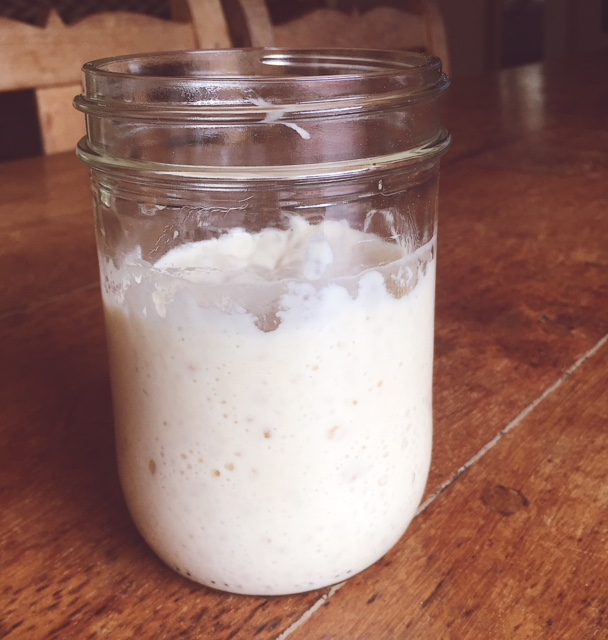
So why should we go through all this trouble?
- Phytic acid is an anti-nutrient in all nuts, grains and seeds that binds nutrients for plant growth and won’t release them until conditions are right for growth. It also interferes with the body’s ability to absorb minerals such as calcium, zinc, iron, magnesium and copper. When dough is acidified with a sourdough culture, it deactivates phytic acid, making nutrients available to our bodies.
- Lengthy fermentation allows for the proper breakdown of complex carbohydrates into simple sugars that become food for the wild yeasts and beneficial bacteria. The by-product of which is carbon dioxide – the wonderful air pockets present in your bread. This is why long-fermented sourdough is considered low-glycemic, unlike the gluten-free breads containing starches like rice and potato flour which will raise your blood sugar.
- Lengthy fermentation allows for the proper breakdown of gluten protein chains that consist of strong peptide bonds between amino acids, cutting it into pieces, making it highly digestible. It’s also a prebiotic, providing food for your good gut bacteria.
- Proper fermentation followed by cooking reduces the amount of lectins and has been shown to neutralize any mycotoxins as well.
- It’s highly gratifying and the results are delicious and make great gifts! Your family, friends and neighbors will thank and love you.
Note that I mentioned “lengthy fermentation”:
The use of commercial yeast does not allow enough time for the above benefits to take place. When baker’s yeast was proposed in France in the late 1800’s, there was concern that there would be devastating health effects.
Did you know that Fleischman’s Rapid Rise Yeast was invented in the mid-1980’s? This allowed for a loaf of bread to be raised in an hour or two, which was great for manufacturers, not so great for us. Add to that the hybridization of wheat, the use of RoundUp to dessicate wheat crops for easy harvesting, spraying containers with pesticides and fungicides before loading them with wheat berries, treating them with chlorine to prevent further mold growth and even irradiating them to kill any other germs, it’s no wonder our bodies don’t do well eating conventionally grown grain!
Therefore, it’s very important to use organic flours and even consider grinding your own grain at home. There are many different grains available to us now that home artisan baking has become so popular, ancient and heritage varieties that have a better profile of gluten-forming proteins that are easier to digest. My ebook recipe outlines a recipe for a 42-hour fermented bread that can also be used as a pizza dough that your family will love!
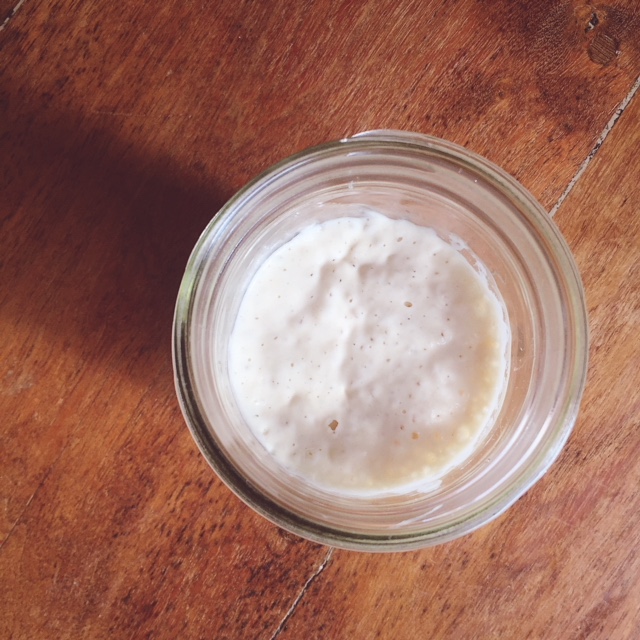
Making Starter Step-By-Step:
The best results for beginning a sourdough starter culture are obtained by using organic whole grain flours, especially rye, which is very high in nutrients and fermentable sugars. It’s very difficult if not impossible to begin a starter with all-purpose flour alone. Mixing by hand will add more bacteria and yeast to your culture in a positive way but is not necessary for success. But working in an environment that is too sterile or regularly cleaned with heavy cleansers and antibacterial agents will work against you.
Within a week your starter should be ready to use for making bread, although it will be most reliable and have a better profile of flavors by 2-3 weeks. In the first week there will be more homofermentative bacteria (lactic acid with an abundance of yeast) and in a few weeks, more heterofermentative bacteria (lactic acid and acetic acid for a better balance of yeast and bacteria) will have taken hold, giving the bread a more complex flavor. Once established, you can continue to feed it with your flour of choice as well as adjust the hydration to your liking.
Ingredients:
- Whole grain organic rye flour
- Whole grain organic wheat flour
- Organic all-purpose flour
- Spring water/filtered water – I do not recommend using tap water because of the chlorine and chloramines in the water that work against natural bacteria and yeast.
Tools:
- Digital scale that measures in grams and has the ability to “tare” or zero out
- 1 qt mason jar
Steps:
Day 1
- Mix 100 grams of whole grain rye flour and 160 grams of water in your vessel and stir with a wooden spoon or chopsticks. Chopsticks are super easy to mix with and clean very easily.
- Scrape the sides clean with a rubber spatula and cover loosely with a lid. Allow it to sit for 24 hours in an area where room temperature will remain consistently between 72º F- 80ºF (24ºC-27ºC). You can also use slightly warm water when mixing if ambient temperature is cool.
- Keep away from other cultures, compost bins, and moldy fruit by at least 6 feet.
Day 2
- Stir mixture and discard 130 grams of mixture.
- Add 100 grams of whole grain rye flour and 160 grams of water and mix well. Scrape the sides clean, cover with lid and let it sit for 24 hours. Mixture should double and fall.
Days 3-6
- Increase feedings to twice a day. Each time, stir mixture and discard 130 grams of starter and add 50 grams of whole grain rye flour and 80 grams of water and cover. Mixture should smell sweet and yeasty, and be doubling and falling with each feed.
- Scrape the inside of your container clean with a rubber spatula and mark the level of freshly mixed starter on the outside of your container with tape or a rubber band so you can track the activity. It should rise and fall.
Day 7
- At this point you should be able to feed your starter with a larger amount of flour.
- In a new container, measure out 50 grams of starter. Add 100 grams of organic flour (50g wheat/50g rye) and 100 grams of water and watch to see if the culture doubles and falls. You will be feeding this twice a day. It’ll be ready to use for bread, but I recommend continuing to feed for 2-3 weeks for best results for bread making. You can switch to 50g flour/50g water once it is healthy and established. Organic all-purpose flour is fine for maintaining the starter after a few weeks of regular feedings have passed, or you can make of mixture of 50% all-purpose and 50% whole grain and use that for feedings.
- Remember to discard extra starter, there really is no need to keep more than 1-2 cups total. The larger in volume your mother starter is, the more you have to feed it to keep it healthy.
Once the starter is very healthy, you can maintain it either at room temperature if you plan on baking regularly or you may decide to store it in the refrigerator with weekly room temperature feedings if you don’t bake very often.
Maintaining at Room Temperature:
If keeping at room temperature, feed your starter at least once a day, but twice is better, especially in warmer months. You will see the signs of the starter not getting enough food if liquid accumulates on top or if it takes on an overly acidic smell. If this should happen, pour off the liquid before you feed your starter again. You can also discard all but a tablespoon of your starter and transfer that to a clean jar before feeding it to freshen it up.
Using a digital scale, zero out the weight of your crock. Add 50 grams of organic all purpose flour and 50 grams of spring/filtered water. Mix well scrape sides clean with a spatula and cover with a cotton dishcloth to absorb any condensation. Scraping the sides clean will prevent thick clumps of starter forming on the inside of your container. Cover with lid.
If you keep your mixture at room temperature and feed daily, your starter will grow. Remember to not let it accumulate to more than about 2 cups in volume. The larger the volume of your starter, the more “mouths” you have to feed and the culture can get weaker because 50g flour/50g water is no longer enough food. You can discard the extra starter or plan to make pancakes, waffles, crackers, etc., with the excess.
If feeding twice a day in the summer months is undesirable, you can remove the bulk of your starter and feed a smaller amount (10g starter) with 50g flour/50g water once a day. If you don’t want to throw excess starter away, you can save discarded starter in a larger container in the refrigerator to make your sourdough discard recipes.
Maintaining in the Refrigerator:
If you decide to keep your starter in the refrigerator, you will need to feed it once a week.
Take your starter out of the refrigerator. Remove a 1/4 cup of the starter and set it aside. Discard the remaining starter, and rinse out your container with hot water. Place clean container on scale and zero out the weight. Add reserved 1/4 cup of starter, noting the weight in grams and adding equal weight in grams of spring/filtered water and organic all purpose flour. Mix and allow to double in volume at room temperature, (roughly 4-6 hours) before returning to the refrigerator to store.
To bake bread, three room temperature feedings are recommended prior to the bread making process in order to wake up the starter. For example, if you wanted to bake on Saturday, take the starter out of the refrigerator Thursday night, and follow the feeding instructions directly above but leave it at room temperature. Feed it again with 50 g flour and 50 g spring/filtered water on Friday morning and Friday evening. It will be ready to use Saturday morning.
Note: the reason why I like to use all-purpose flour is because of the reliability and rate at which the starter culture feeds on it, similar to using sugar to feed a kombucha scoby. It’s also less expensive than using fresh ground flour and I feel less guilty tossing excess if I don’t have time to use it in a starter recipe.
Keep away from other cultures, compost bins, and moldy fruit by at least 6 feet.
Now that you find yourself with excess starter, what would you like to do with it?
There are many recipes that you can search for online. But don’t feel guilty if you don’t have time and you’d like to just throw it away. Thankfully my septic tank is happy to have the extra beneficial bacteria! I had one student from my class confess that she had jars and jars of it taking space in her refrigerator because she felt terrible throwing it away! It can be stored for a week before it starts to get sour, but I wouldn’t store more than 2 cups at a time.

Final Thoughts:
Below is my family’s favorite recipe for Belgian waffles. You can also use this recipe for pancakes as well. We have long since removed all Teflon non-stick cookware from our home, so here is the waffle maker that I like using.
I hope that you decide to embark on a sourdough journey…it’ll be more rewarding than you think and creating self-sufficiency for yourself and your family will be well worth it. If you have children, it’s a wonderful activity to get them involved in and they will be so proud of themselves! And there are so many things to be learned in a process like this for everyone involved. Besides the science and nutrition, there’s the act of slowing your pace to the dough that brings reflection and mindfulness, employing all your senses…and communing at a table together or sharing a loaf made with love. The blessings will abound!
Sourdough Belgian Waffles
Makes: 4 Large Belgian Waffles
Recipe By: Min Kim
Ingredients
- ¼ cup/56 grams melted butter or coconut oil, cooled and not too hot
- 2 cups/550 grams sourdough starter
- 2 pastured eggs
- 2 tablespoons sweetener of choice: honey, coconut sugar, rapadura/muscovado, organic unrefined sugar, etc., can omit as well
- ½ teaspoon celtic sea salt/Himalayan pink salt
- 1 teaspoon vanilla extract
- 1 teaspoon baking soda
Instructions
- Melt butter or oil over low heat. Plug in waffle iron.
- In a medium size bowl, combine sourdough starter, eggs, sweetener if using, salt and vanilla extract. Whisk until well blended. Add in melted butter or coconut oil and whisk until incorporated.
- When waffle maker is hot and ready to use, add in the baking soda. Mix well but don’t over mix. Batter will puff and become pillowy.
- Start making waffles according to your machine’s instructions.
- Serve with lots of butter, raw whipped cream or coconut cream, berries and real maple syrup!
Notes
These waffles freeze very well, just toast and you are ready to go!
 Min Kim’s love for cooking began in childhood. However, it wasn’t until she learned about Dr. Weston A. Price’s research and the GAPS Diet that she began the journey that eventually led her to becoming a Traditional Foods Cook. She now teaches both group and private cooking classes, teaching clients how to prepare bone broths, true fermented sourdough breads, properly soaked grains and legumes, lacto-fermented vegetables and cultured dairy. Follow her on Instagram at @minskitchen to further learn tips and enjoy her beautiful creations.
Min Kim’s love for cooking began in childhood. However, it wasn’t until she learned about Dr. Weston A. Price’s research and the GAPS Diet that she began the journey that eventually led her to becoming a Traditional Foods Cook. She now teaches both group and private cooking classes, teaching clients how to prepare bone broths, true fermented sourdough breads, properly soaked grains and legumes, lacto-fermented vegetables and cultured dairy. Follow her on Instagram at @minskitchen to further learn tips and enjoy her beautiful creations.
Please Note: This post contains affiliate links. If you make a purchase using these links, there’s no additional charge to you, and I will receive a small commission from the company. This helps to cover the basic costs of this website and allows me to continue providing you with free content. Thanks so much for your support!

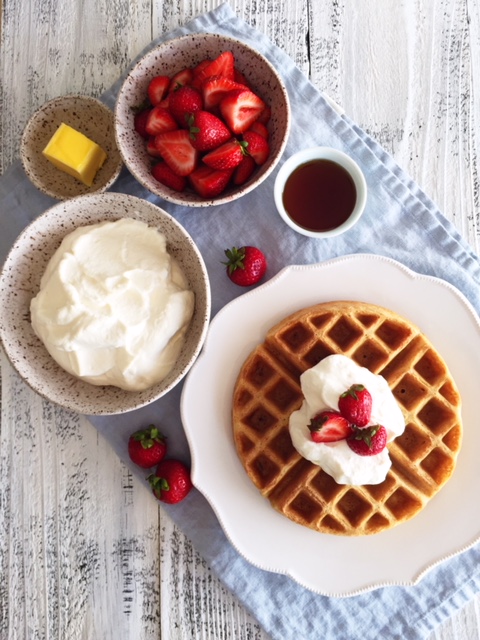
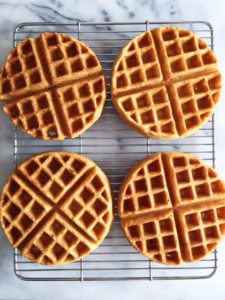

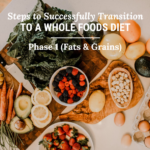










Is this measured in grams by weight and not volume for flours and water? Thanks
It’s grams by weight. Thanks!
I made this. Light airy and crisp. So delicious, and a great use for sourdough that’s getting ahead on you.